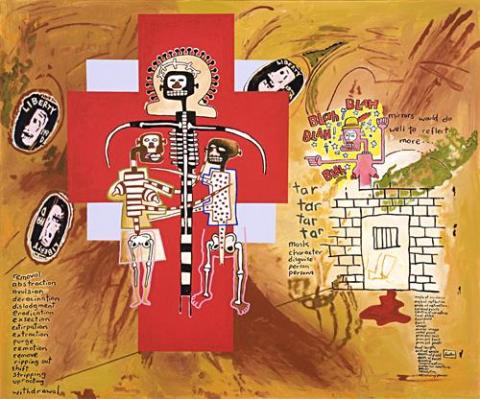NOTES TO BASQUIAT: LIBERTY, 2000
Gordon Bennett
synthetic polymer paint on linen
152.0 x 188.5 cm
signed, dated and inscribed verso upper left: G.Bennett 9-6-2000 / Notes to Basquiat: Liberty / acrylic / 152 x 188cm
Irene Sutton Gallery, Melbourne
Private collection, Melbourne
Since his first major solo exhibition in 1989, Gordon Bennett has achieved international acclaim for his highly idiosyncratic vision which, drawing inspiration from Australia's colonial past and postcolonial present, interrogates the power of language to structure the ideologies that so determine our cultural and personal identities. Indeed, more explicitly than any other Australian artist, he has engaged in the debate on republicanism, sovereignty (land rights) and citizenship in an effort to highlight the plight of Indigenous people - not just locally, but internationally - who have become estranged as a result of colonialism. Arguing that the codes of Western art, literature, law and science introduced with European settlement have become a prison from which Indigenous people cannot escape - rather, only appropriate - thus Bennett employs the deconstructivist aesthetic of postmodernism to re-present the histories and politics underlying our social landscape.
In 1998, seeking to communicate his concerns to an American audience, Bennett embarked upon his celebrated 'Notes to Basquiat' series inspired by the work of Jean-Michel Basquiat, the African-American artist based in New York who shared a similar preoccupation with semiotics and visual language as instruments of marginalisation. Conceived as an 'open letter' to Basquiat who died a decade earlier, the series emulates the raw street style for which the American artist became renowned, thus emphasising 'our shared experience as human beings in separate worlds that each seek[s] to exclude, objectify and dehumanise the black body and person.'1 In Notes to Basquiat: Liberty2000, this sense of commonality or shared stereotyping of 'blackness' is intimated by the black skeletal structure embracing both indigenous and African American figures below,and powerfully reinforced by the artist's deliberate evocation of Basquiat's rap-like banter: 'angle of incidence/ angle of reflection/ cardinal points/ centre of curvature etc'- Yet if Bennett borrows, he 'does not simply imitate or act as Basquiat...'2
As the lists of words here roll off the tongue or scroll through the mind of the viewer, such lyrics implicate the viewer in a performative engagement which extends beyond the text itself to highlight the highly ambiguous, complex links between sight, speech and thought - or more broadly, between history and meaning - upon which his entire oeuvre is predicated. In a similar vein, the declaration to the right-hand side of the composition - 'mirrors would do well to reflect more' - alludes to a space in which different perspectives may be possible. Although frequently appearing in his work as an emblem of the Eurocentric mindset and value system - 'the narcissistic regime of colonialism' - the mirror also offers a dynamic opportunity for self-investigation and transformation; as Ian McLean explains, 'For [Bennett] the reflective surface of the mirror not only upturns [inverts] the real world of colonialism, but is a liminal zone where the discourses of colonialism are exceeded, the past and future re-negotiated, and history re-written.'3
1. Bennett quoted in Gordon Bennett, National Gallery of Victoria, Melbourne, 2007, p. 21
2. Jill Bennett cited ibid.
3. McLean, I., 'Philosophy and Painting: Gordon Bennett's Critical Aesthetic' in McLean, I., & Bennett, B., The Art of Gordon Bennett, Craftsman House, 1996, p. 88
VERONICA ANGELATOS
